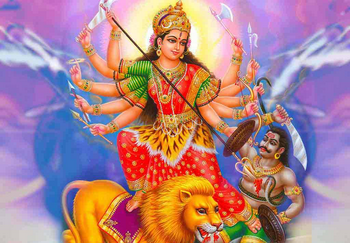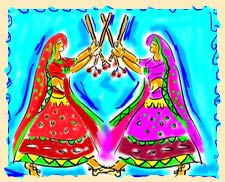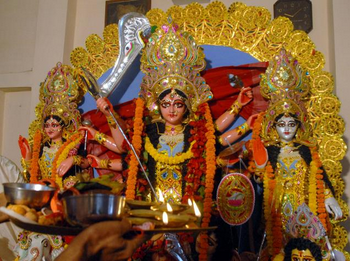 One of the most important festivals of India, which is celebrated in various parts of the country with great enthusiasm, is Dasara. People in different parts celebrate in different ways according to their customs and conventions in the month of October. This festival is generally celebrated for ten days, during which time the goddess Adishakthi is worshipped by various names and in various forms. Durga, Kali, Annapoorna, Sarvamangala, Bhairavi, chandika, Rajarajeswari, Bhavani, Sakambari, Saraswathi, Mahishasuramardini are some of the names by which this goddess is referred.
One of the most important festivals of India, which is celebrated in various parts of the country with great enthusiasm, is Dasara. People in different parts celebrate in different ways according to their customs and conventions in the month of October. This festival is generally celebrated for ten days, during which time the goddess Adishakthi is worshipped by various names and in various forms. Durga, Kali, Annapoorna, Sarvamangala, Bhairavi, chandika, Rajarajeswari, Bhavani, Sakambari, Saraswathi, Mahishasuramardini are some of the names by which this goddess is referred.
Among the ten days, the ninth day, which is called Maharnavami, is very important. The day before Navami (Ashtami) is believed to be the day of incarnation of the goddess and the day next to Navami (Dasami) is considered, as the termination day of evil by the goddess. The three days are treated as the important festive days.
The goddess is consecrated at the holy place of worship and the holy fire is lit. Then people offer prayers to the goddess and the Sri Chakra (the weapon of lord Vishnu). Prayers are offered to the goddess in the morning and rituals like Sumangali pooja or Kanyaka pooja are followed in the evenings. Among the three types of worship, Rajasa, Thamasa and Sathvika, animal offerings are made in Rajasa and Thamasa type while Coconuts are offered in the third type i.e., the Sathvika. Coconut offering is equivalent to human sacrifice according to the story of sage Vishwamithra, who created coconut, which resembled human head, in his attempt to create a New World, which was stopped later.
In earlier times, in some parts of the country especially in Calcutta, it was a custom to perform "Makara Panchaka Poojalu". People who practised sorcery, in the hope of getting magical powers offered fish, meat, liquor etc., to the goddess. A girl child or a virgin was usually worshipped in the name of Kalika Devi. She is made to consume all the above in order to propitiate Kali and obtain magical powers in return. This worship is usually carried out at midnight. Such offerings were earlier common at the Kali temple of Calcutta.
Vijaya Dasami
"Vijaya Dasami" is the last day of the festival. As the name suggests (Vijaya means victory), it is the day of celebration of victory. According to various religious books and epics, this is the day of victory of the Good over Evil. Sree Rama won against Ravanasura on the same day. After the exile of one year Arjuna took possession of his armoury kept concealed on the Sami Vriksha (Presopis Spicigera) and conquered his enemies. Thus the Day of Dasami came to be known as the victory day or Vijaya Dasami. From that day onwards the tree is also worshipped to get rid of one’s enemies and sins. As per the Epic Karthika Purana emperor Raghu conquered Kubera and took possession of his wealth on this same day. Goddess Adi Shakti killing Mahishasura on Vijaya Dasami has made this day very important.
Dasara (Vijaya Dasami) - The story of Mahishasura
"Adi Shakti" is often called "Mahishasura Mardini" as the goddess killed the demon Mahishasura. Mahishasura, the son of Diti, was born under the curse by the sage Suparsva with the face like that of a buffalo and a human torso. Mahishasura did penance of Lord Shiva and was given a boon to be killed only by a woman. Then to stop the atrocities of Mahishasura against the Gods and humans, Adi Shakthi incarnated with the name of Narayani. On sage Narada's advice and much against the suggestion of Praghana, his Minister Mahishasura went to Narayani to ask her to marry him. Enraged with his desire she kills him, there by getting the name 'Mahishasura Mardini'.
Dasara (Vijaya Dasami) - Dasara Celebrations
In the villages, the festival offers a different picture. The folk entertainers come in a variety of fancy dresses, that of a soldier, Mahishasura, Shiva, a tiger or a Cheetah etc. Some exhibit folk arts like, piercing knives across  the cheeks or hanging iron pegs from bare bodies. The school children visit all the houses in the village asking for sweets and money. They carry bows and arrows with a funnel like attachment to pore out colour powder on others as a gesture of celebration. Children are given Dal and Jaggery to eat and enjoy. Even slates and pencils are also distributed as a goodwill gesture on this festival day. Parents make their children to go before their teachers to be blessed by them and the teachers are offered beatel leaves as a mark of respect.
the cheeks or hanging iron pegs from bare bodies. The school children visit all the houses in the village asking for sweets and money. They carry bows and arrows with a funnel like attachment to pore out colour powder on others as a gesture of celebration. Children are given Dal and Jaggery to eat and enjoy. Even slates and pencils are also distributed as a goodwill gesture on this festival day. Parents make their children to go before their teachers to be blessed by them and the teachers are offered beatel leaves as a mark of respect.
In olden days kings would perform "Ayudha Pooja" and setout for invasion or hunting. The hunted animal would be offered as sacrifice to the local deity. In some parts People organize "Seemo Langhanam" or "Silangan", by conducting wrestling. "Vijaya Dasami is considered as an auspicious day for starting new ventures. This festival is celebrated Country wide with equal fervour and spirit. In Vijayawada, a town in Andhra Pradesh, it is a special occasion for the people to worship Kanaka Durga, the goddess situated on Indra Keeladri Mountain. This goddess is worshipped for all the ten days with ten different names Kanaka Durga, Chamundi, Gayatri Devi, Annapoorna, Sree Lalitha, Thripura Sundari, Bala Thripura sundari, Saraswathi, Durga, Mahishura Mardini and Raja Rajeswari. In parts of Telangana Batukamma Festival is celebrated during this festive period. Batukamma is a deity made with different flowers. Women folk will gather around the deity singing and dancing. They immerse this Batukamma in the river on the last day.
Dasara (Vijaya Dasami) - Celebrations in Various Parts of India
It is believed that Chamundeswari fought with Mahishasura for nine days on a hill presently called Chamundi hill in Mysore. So the people of Mysore celebrate this festival with much grandeur. Presently the Karnataka Government is organising this festival, which was once patronised by kings. Kannadigas believe that goddess Durga will be in sleep from Ashada, shukla ashtami (8th day of Ashada month). Hence, she is awakened during Navarathri. This act of awakening is called Bodhana by them
- 1st day of Navarathri – idol installation day
- 2nd day of Navarathri – Offering of ribbons for her hairdo
- 3rd day – Colour the feet of Goddess by turmeric and offer a mirror for her dressing up
- 4th day – Offering of a sweet preparation called Madhuparkam
- 5th day – Offering of scent, cosmetics and Jewellery
- 6th day – Invocation of Goddess Chamundi into ‘Bilwa’ tree
- 7th day to 9th day (3 days) - performance of special pujas
- 10th day Dasami – Procession of elephants with torches lit behind them. Lakhs of people throng to witness this exhibition of elephants. Fire works are lit all through the procession.
Dasara (Vijaya Dasami) - Astrological Importance
 The constellation Virgo appears on Leo at the time of sunset, during the festival period, which depicts the picture of goddess Adishakti on a Lion. Navarathri comes in the season of Sarad Rutuvu with clear skies. Moonlight will be bright as moon happens to be the brother of Goddess Lakshmi, since both have emerged out of the churning of milky ocean by the Angels and Demons. He shines bright to help his sister in fight with Mahishasura, during the nights.
The constellation Virgo appears on Leo at the time of sunset, during the festival period, which depicts the picture of goddess Adishakti on a Lion. Navarathri comes in the season of Sarad Rutuvu with clear skies. Moonlight will be bright as moon happens to be the brother of Goddess Lakshmi, since both have emerged out of the churning of milky ocean by the Angels and Demons. He shines bright to help his sister in fight with Mahishasura, during the nights.
Propitiation through the 3 flour patterns (Rangoli).
There are 3 Rangolies, which are specially liked by the three Goddesses lakshmi, Saraswati, Durga. During Navarathri these 3 Rangolies decorate the seat of the Goddess Durga.
Favourite Rangoli of Durga
This is a pattern of a dot in the centre with five dots on the eight corners. They are joined in a particular pattern, which according to Astrology will subdue Rahu Dhoshum.
Favourite Rangoli of Lakshmi
This is a Rangoli of one, three, five, two and four dots with a particular pattern of joining them. This Rangoli if worshipped during Dasara brings wealth to all.
Favourite Rangoli of Sarswati
This is a pattern of joining first dot with the fourth one, fourth to second and second to fifth and fifth to third.
It is believed that Durga’s favourite Rangoli should be worshipped on the first 3 days, Lakshmi’s favourite Rangoli in the second 3 days and Saraswati’s Favourite Rangoli on the last 3 days. This worship brings health, wealth, and knowledge to one and all. It is said that these Rangolies can be worshipped during the normal days also. These Rangolies can also be prepared using coloured beads on a cardboard on a auspicious day for decoration and worship. Therefore, with all these features this festival stands as the most important festival for the people of India.